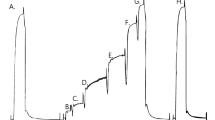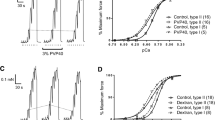Abstract
A freeze-drying method is described by which single skinned skeletal muscle fibres or fibre bundles can readily be obtained. Skinned fibre segments of the ileofibularis and semitendinous muscles of the frog — activated by means of a rapid increase in the Ca-concentration — showed very stable and reproducible contractions. Complete activation occurred at a Ca-concentration of 1.6·10−6 M and the mid-point of the pCa-tension curve occurred at 6.3·10−7 M. Addition of phosphate (≤10−2 M) had a depressing effect on the speed of the Ca-activated tension development as well as on the maximum tension reached.
Addition of caffeine (10−2 M) had no effect on the tension generation, indicating that the sarcoplasmic reticulum, if present, was not active. The force responses due to rapid length changes applied to the Ca-activated fibre preparations were found to be qualitatively similar to the force responses on intact tissue. This skinning technique might be employed on human biopsies, enabling the measurement of physiological parameters such as for example force and shortening velocity.
Similar content being viewed by others
References
Brandt PW, Cox RN, Kawai M, Robinson T (1982) Regulation of tension in skinned muscle fibers. Effect of cross-bridge kinetics on apparent Ca2+ sensitivity. J Gen Physiol 79:997–1016
Dawson MJ, Gadian DG, Wilkie DR (1978) Muscular fatique investigated by phosphorus nuclear magnetic resonance. Nature 274:861–866
Fabiato A, Fabiato F (1979) Calculator programs for computing the composition of the solutions containing multiple metals and ligands used for experiments in skinned muscle cells. J Physiol (Paris) 463–505
Ford LE, Huxley AF, Simmons RM (1977) Tension responses to sudden length change in stimulated frog muscle fibres near slack length. J Physiol 269:441–515
Goldman YE, Simmons RM (1977) Active and rigor stiffness. J Physiol 269:55–57P
Griffiths PJ, Güth K, Kuhn HJ, Rüegg JC (1980) Cross bridge slippage in skinned frog muscle fibres. Biophys Struct Mech 7:107–124
Güth K, Kuhn HJ, Drexler B, Berberich W, Rüegg JC (1979) Stiffness and tension during and after sudden length changes of glycerinated single insect fibrillar muscle fibres. Biophys Struct Mechanism 5:255–276
Herzig JW, Rüegg JC (1977) Myocardial cross-bridge activity and its regulation by Ca2+, phosphate and stretch. In: Riecker G, Weber A, Goodwin J (eds) Myocardial failure. Springer, Berlin Heidelberg New York, pp 41–51
Herzig JW, Yamamoto T, Rüegg JC (1981) Dependence of force and immediate stiffness on sarcomere length and Ca2+ activation in frog skinned muscle fibres. Pflügers Arch 389:97–103
Heinl P (1972) Mechanische Aktivierung und Deaktivierung der isolierten contractilen Struktur des Frosch-Sartorius durch rechteckförmige und sinusförmige Längenänderungen. Pflügers Arch 333: 213–226
Hopkins AL (1955) Effects of lyophilization of the contractile mechanism of muscle. Fed Proc 14:75–76
Huxley AF (1980) The mechanical properties of cross-bridges and their relation to muscle contraction. In: Varga E, Kövér A, Kovács T, Kovács L (eds) Molecular and cellular aspects of muscle function, Adv Physiol Sci, vol 5. Pergamon Press Ltd Oxford and Akadémiai Kiado Budapest, pp 1–12
Julian FJ, Moss RL (1981) Effects of calcium and ionic strength on shortening velocity and tension development in frog skinned muscle fibres. J Physiol 311:179–199
Kushmerick MJ, Krasner B (1982) Force and ATPase rate in skinned skeletal muscle fibers. Fed Proc 41:2232–2237
Magid A, Reedy MK (1980) X-ray diffraction observations of chemically skinned frog skeletal muscle processed by an improved method. Biophys J 30:27–40
Moisescu DG (1976) Kinetics of reaction in calcium-activated skinned muscle fibres. Nature 262:610–613
Moisescu DG, Thieleczek R (1978) Calcium and strontium concentration changes within skinned muscle preparations following a change in the external bathing solution. J Physiol 275:241–262
Müller H (1958) Dehydrated muscle fibers. Proc Natl Acad Sci 44: 235–238
Portzehl H, Caldwell PC, Rüegg JC (1964) The dependence of contraction and relaxation of the muscle fibres from the crab Maja squinado on the internal concentration of free calcium ions. Biochem Biophys Acta 79:581–591
Robertson SP, Kerrick WGL (1979) The effects of pH on Ca2+-activated force in frog skeletal muscle fibers. Pflügers Arch 380:41–45
Rüegg JC, Schädler M, Steiger GJ, Müller G (1971) Effects of inorganic phosphate on the contractile mechanism. Pflügers Arch 325: 359–364
Stephenson EW (1981) Activation of fast skeletal muscle: contributions of studies on skinned fibers. Am J Physiol 240:C1-C9
Stienen GJM, Blangé T (1980) A quantitative analysis of the force transients of skeletal muscle in response to quick changes in length. In: Baan J, Arntzenius AC, Yellin EL (eds) Cardiac dynamics. Martinus Nijhoff Publishers, The Hague, pp 69–78
Stienen GJM, Blangé T (1981) Local movement in stimulated frog sartorius muscle. J Gen Physiol 78:151–170
Author information
Authors and Affiliations
Rights and permissions
About this article
Cite this article
Stienen, G.J.M., Güth, K. & Rüegg, J.C. Force and force transients in skeletal muscle fibres of the frog skinned by freeze-drying. Pflugers Arch. 397, 272–276 (1983). https://doi.org/10.1007/BF00580260
Received:
Accepted:
Issue Date:
DOI: https://doi.org/10.1007/BF00580260




